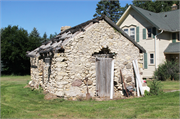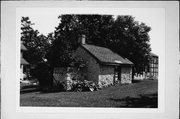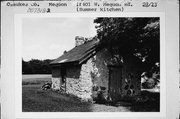| Additional Information: | DESCRIPTION
The main house on theis property is a two-story gable ell house that has steeply-pitched gables. clapboard siding and a fieldstone foundation. Indows are mostly tall and topped with cornice lintels. An ell porch with curved brackets and plain square post is on the front facade.
The second house on this property is a combination frame, limestone, and half-timber houses. The half timber house is a rectangular building with a German timber frame that is filled in with wattle and daub nogging made of the cream colored clay flund in eastern Wisconsin. There are some crude windows that are filled in with six-over-six light double hung sashes. There is a low-pitched gable roof and the gables are covered with clapboards. The house sits on a fieldstone foundation.
Attached to the half-timber house is a one and one-half story ell constructed limestone rubble. It has a low-pitched gable rood covered with wood shingles. The window openings have segmental stone arches and six-over-six light double hung sashes. A porch spands one side of the ell. It is made up of rough-hewn round post and a balustrade of fense boards.
Attached to the half-timber house is a one and one-half story fram ell. It has a steeply-pitched gable roof covered with wood shingles, clapboard siding, and a wll porch with a shed roof and plain square post. Windows are two-over-two light double hung sashes decorated with cornice lintels.
Also on the property is a fieldstone summer kitchen. It is a one-story small, square building with a low-pitched gable toof and crude openings fram with wood. A small projection from the end wall is probably a bake oven. A chiminy made of cream bricks rises from one end of the building.
A gable-roofed basement barn is also on the property. It has board siding, large sliding doors and a fieldstone foundation. An early twentieth century concrete silo sits at one end of the barn. Completing the farm complex is a machine shed/animal stable. It has board siding, large sliding doors at one end are walls constructed of fieldstone.
ARCHITECTURAL/ENGINEERING SIGNIFICANCE
It has outstanding examples of two German buildings that were common to the German settlers in Mequon and southeastern Wisconsin. They are the half-timber house and fieldstone-constructed summer kitched and/or smokehouse. THe half-timber portion of the older home on the property is in excellent condition adn illistrates well the German half-timber house. These half-timber houses were once common in the Milwaukee area, but many have been demolished and there are probably a number of examples that exist outside museum settings.
The fieldstone summer kitchen is also a fine example of both its type of construction and its type of building. The extention off the rear of the building is not seen in other smokehouses or summer kitchens in Mequon, which there are many.
The stone frame and additions to the half-timber house are also significant, one for its limestone construction, and the other is its expression of typical building techniques found on the frame houses of this vintage in the area. The large frame houses is a fine example of the gaded ell vernacular form. Many vernacular houses exist in Mequon and many are of the gabel ell form. But few have the level of preservation and integrity that this building has. Overall, this entire farmstead is a fine and intact example of a nineteeth and early twentieth century German farmstead and every effort should be made to perseve it as intact as possible.
HISTORICAL BACKGROUND
Karl Ludwig and Wilhelm
This farmstead was owned by Ludwig Hilgendorf between 1842 and 1892 and by J. J. Hilgendorf still owned the property. Wilhelm Ludwig was born April 16, 1832 in Treptow, Northern Germany. He came with his father, Karl Ludwig Hilgendorf, to Mequon as part of the Freistadt settlement. The Freistadt settlement was a group of immigrants from northern Germany who were at odds with the German rulers in regard to the practice of their Lutheran religion. THe earliest Freistadt immigrants cane in 1839, some settling near Buffalo, New York and the rest coming to a town called Mequon. Karl Ludwig Hilgendorf probably built the original half-timber section of the older home on the property. Later, his son, Wilhelm Ludwig, probably added the additions. The date of construction of the newest house on the property suggest that it may have been built for the next generation of Hilgendorfs, the J.J. Hilgendorf family. [a,b,c]
J.J. Hilgendorf was probably responsible for the construction of the barn and the machine shed/animal stable.
HISTORICAL SIGINIFICANCE
The Freistadt settlers cane to Wisconsin for religion freedom. They came in groups throughout the nineteeth and even twentieth century, maintained close ties with each other. They formed their own church and school and intermarried frequently. The Freistadt settlers were an important a significant ethnic group in Mequon and in southeastern Wisconsin and the Hilgendorf family was one of the most prosperous and prominent families amoung the Freistadt community. Because of their association with the Freistadt settlement and because this farmstead has fine examples of ethnic German construction and building types, the Hilgendorf farmstead is significant in southeastern Wisconsin.
2022 - House and farm resurveyed by HRL. Little apparent change. House/farm determined NR ELIGIBLE in 2015. Update photo. |
|---|
| Bibliographic References: | [a] Plat Maps for the city of Mequon, 1867-1980, on file at the Mequon Historical Society, Mequon, Wisconsin, or the Archives at the State Historical Society, Madison, Wisconsin.
[b] Tax Rolls for the city of Mequon, 1857-1930, on file at the library, Mequon, Wisconsin.
[c] Field observation based on architectural and historical information.
[d] Information from the owner of the property.
[e] Information from the building's datestone or inscription.
[f] Freistadt Historical Society, Freistadt and the Lutheran Immigration, Mequon: Trinity Evangelical Lutheran Church, 1989.
[g] L. Rehm, Mequon History, on file at the Mequon Historical Society, Mequon, Wisconsin.
[h] C.W. Butterfield, History of Washington and Ozaukee Counties, Chicago: Western Publishing Company, 1880.
[i] Information from the Mequon Landmarks Commission, Mequon, Wisconsin. |
|---|



